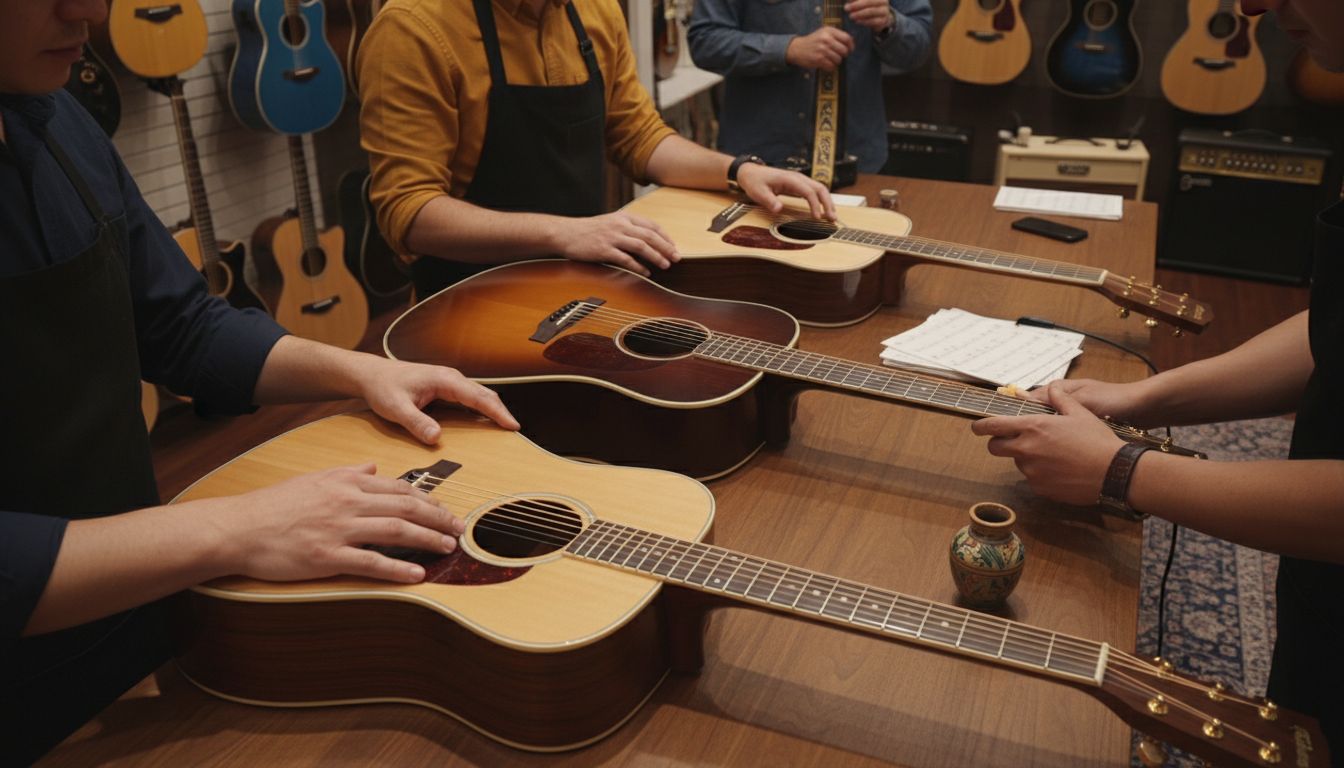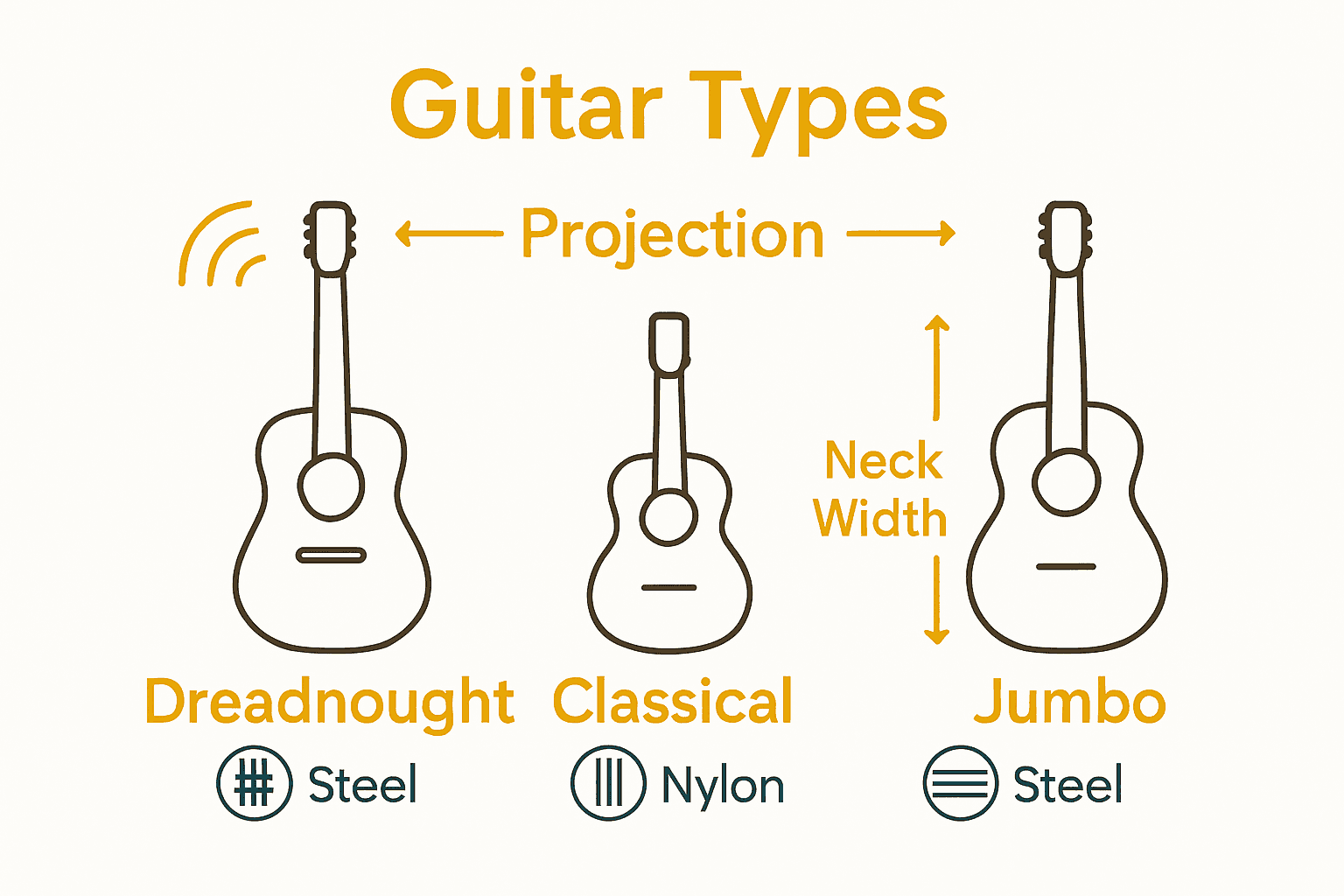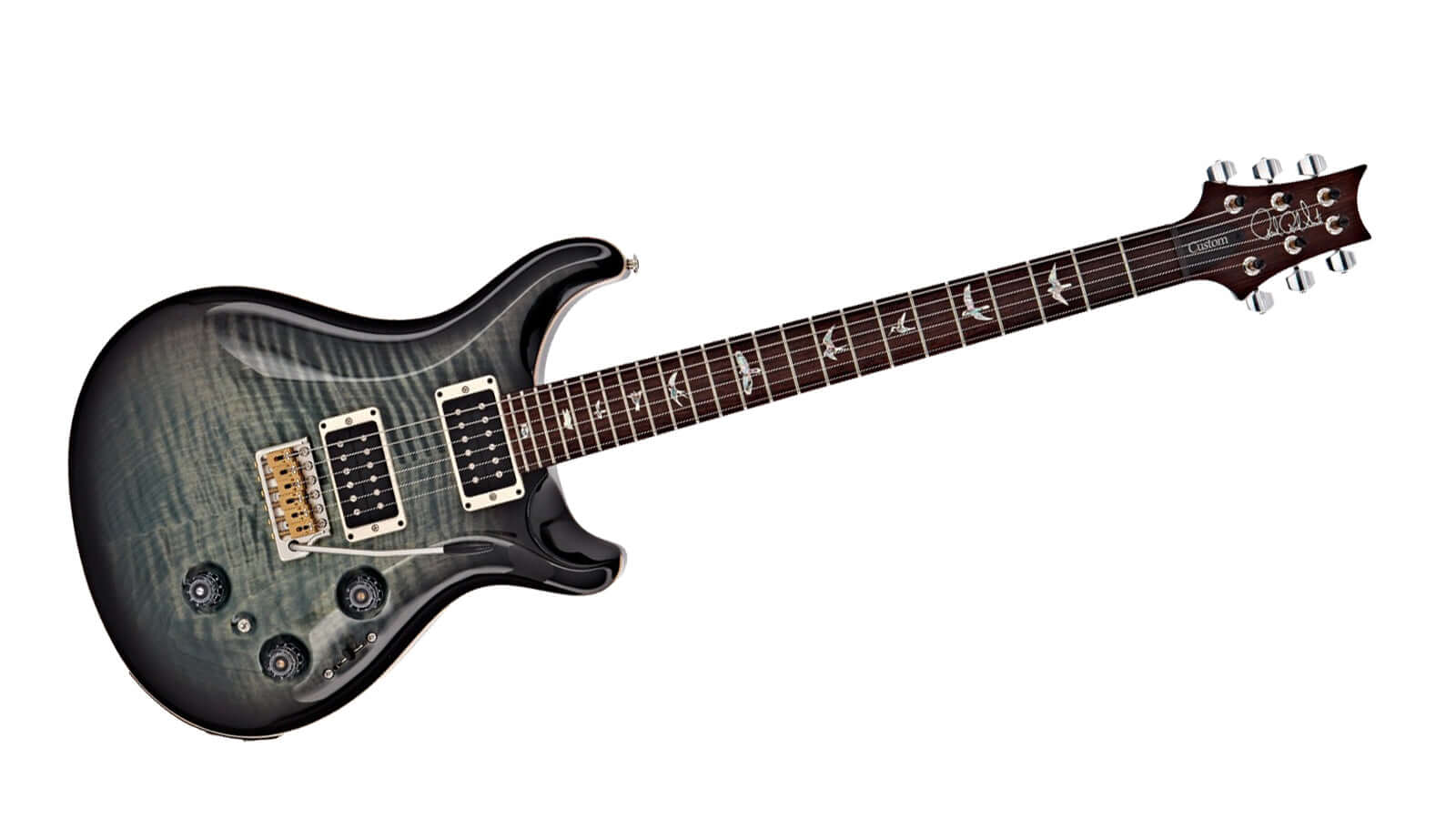More than a century after its debut, the dreadnought guitar remains one of the most popular choices for musicians worldwide. Its bold sound and unmistakable silhouette have shaped countless musical genres, from country anthems to rock ballads. The oversized body delivers dramatic projection and deep bass that smaller guitars simply cannot match. If you want to understand why this instrument stands out on stage and in the studio, exploring the dreadnought’s distinctive features and history reveals what makes it such a powerful favorite.
Table of Contents
- Defining The Dreadnought Guitar Type
- Body Shape, Size, And Distinct Features
- Variations And Modern Adaptations Of Dreadnoughts
- Tone, Playability, And Typical Use Cases
- Comparing Dreadnoughts With Other Acoustic Guitars
- Common Mistakes When Choosing A Dreadnought
Key Takeaways
| Point | Details |
|---|---|
| Dreadnought Design | The dreadnought guitar features a large body for enhanced acoustic projection, making it ideal for genres like country, folk, and blues. Its design includes a broader body shape, deeper sound chamber, and robust sound capabilities. |
| Playability Versatility | Known for its comfortable neck profile, the dreadnought supports both aggressive strumming and delicate fingerstyle, catering to various musical techniques. |
| Modern Innovations | Contemporary dreadnoughts now incorporate features like cutaway designs and electronic pickups, broadening their usability in diverse musical settings. |
| Choosing the Right Fit | Musicians should consider body size and playing technique compatibility when selecting a dreadnought to ensure comfort and optimal sound quality. |
Defining the Dreadnought Guitar Type
The dreadnought guitar represents a revolutionary design in acoustic guitar history, transforming musical soundscapes with its distinctive large body and powerful acoustic projection. Named after the formidable British battleship HMS Dreadnought, this guitar type emerged in the early 20th century through the innovative craftsmanship of C.F. Martin & Company udspace.
Originally designed for the Ditson Company, dreadnought guitars featured a significantly larger body compared to previous acoustic guitar models. This design breakthrough provided musicians with a deeper bass response and unprecedented sound volume, making it an instant favorite among country, folk, and blues performers. The expansive body shape allowed for greater sound projection, enabling musicians to cut through ensemble arrangements with remarkable clarity stern.
The defining characteristics of a dreadnought guitar include:
- Broader, squarer body shape
- Deeper sound chamber
- Enhanced low-end frequencies
- Robust, powerful acoustic projection
- Versatility across multiple musical genres
By the 1930s, the dreadnought had become a standard in acoustic guitar design, championed by legendary musicians like Johnny Cash and Elvis Presley. Its unique sonic signature transformed how musicians approached acoustic performance, bridging traditional musical styles with emerging contemporary sounds.
Body Shape, Size, and Distinct Features
The dreadnought guitar stands out with its bold and distinctive physical architecture, significantly differing from other acoustic guitar designs. According to tenstrings, these guitars feature a notably larger body compared to classical guitars, accompanied by a thinner neck and steel strings that contribute to their unique tonal characteristics.
A typical dreadnought guitar is characterized by its broad, squared shoulders and deep body, which create a dramatic silhouette that sets it apart from more rounded guitar designs. This expansive body shape is intentionally engineered to maximize sound projection and produce a robust, full-bodied tone. The increased internal volume allows for enhanced resonance, particularly in the lower frequency ranges, giving dreadnought guitars their signature powerful sound.
Key physical attributes of dreadnought guitars include:
- Broad, squared body shape
- Deeper sound chamber compared to smaller guitar types
- Typically 20 inches long
- Width ranging between 15-16 inches
- Thinner neck profile for enhanced playability
The steel strings and larger body construction make dreadnought guitars particularly well-suited for aggressive strumming techniques used in genres like country, rock, and folk music. Its versatile design enables musicians to achieve both powerful rhythmic accompaniment and nuanced fingerstyle performances, making it a favorite among professional and amateur musicians alike.

Variations and Modern Adaptations of Dreadnoughts
The dreadnought guitar has undergone significant evolution since its original design, with manufacturers exploring diverse wood combinations and construction techniques to refine its sonic characteristics. stern notes that Martin Guitar has been at the forefront of this innovation, introducing models like the D-1 with mahogany bodies and the D-2 featuring rich rosewood construction, each offering distinct tonal qualities that appeal to different musical preferences.
Modern dreadnought variations have expanded beyond traditional wood selections, incorporating innovative materials and design modifications. Contemporary luthiers now experiment with alternative tonewoods like spruce, cedar, and exotic hardwoods to create instruments with unique sound signatures. Some manufacturers have introduced cutaway designs that provide musicians easier access to higher frets, while others have integrated advanced electronic pickups for amplified performances.
Key modern dreadnought adaptations include:
- Cutaway body styles for improved upper fret access
- Integrated electronic pickup systems
- Hybrid wood constructions
- Lightweight materials for enhanced portability
- Advanced bracing techniques for improved resonance
These evolutionary changes reflect the dreadnought’s continuing relevance across multiple musical genres, from traditional folk and country to contemporary indie and singer-songwriter styles. By balancing classic design principles with modern technological innovations, manufacturers ensure the dreadnought remains a versatile and beloved instrument for musicians worldwide.
Tone, Playability, and Typical Use Cases
The dreadnought guitar delivers a remarkable sonic experience that has captivated musicians across multiple genres. tenstrings highlights that these guitars are renowned for their powerful, resonant sound with an exceptionally strong bass response, making them particularly versatile for genres like country, pop, and rock music.
Playability is another hallmark of the dreadnought design, with its larger body and carefully engineered neck profile allowing musicians to explore diverse playing techniques. The instrument’s robust construction enables aggressive strumming patterns typical in rock and country music, while simultaneously supporting delicate fingerstyle approaches used in folk and blues traditions. Its balanced tonal characteristics mean players can transition seamlessly between rhythmic accompaniment and nuanced melodic passages.
Typical use cases for dreadnought guitars span a wide musical spectrum:
- Rhythm guitar in rock and country bands
- Solo acoustic performances
- Fingerstyle folk and blues playing
- Campfire and informal group music sessions
- Recording studio environments requiring strong acoustic presence
With understanding the perfect guitar tone being crucial for musicians, the dreadnought offers an incredibly adaptable platform. Its inherent tonal characteristics make it an excellent choice for musicians seeking an instrument that can handle multiple playing styles and musical expressions with remarkable consistency and depth.
Comparing Dreadnoughts With Other Acoustic Guitars
Dreadnought guitars stand distinctly apart from other acoustic guitar styles, offering a unique blend of sonic characteristics and playing versatility. tenstrings highlights a critical difference between dreadnoughts and classical guitars: while classical guitars are designed with nylon strings and wider necks for intricate fingerstyle playing, dreadnoughts feature steel strings and a thinner neck, making them significantly more adaptable across multiple musical techniques.
The primary distinctions between dreadnought and other acoustic guitar types become apparent in their physical construction and tonal qualities. Compared to parlour guitars, dreadnoughts offer a substantially larger body that produces a more pronounced bass response and greater volume. Similarly, unlike jumbo guitars which can feel unwieldy, dreadnoughts maintain a balanced profile that makes them comfortable for extended playing sessions while delivering robust sound projection.
Key comparative features include:
- Steel vs nylon string configurations
- Neck width and profile variations
- Body size and sound projection differences
- Tonal response across musical genres
- Versatility in playing techniques
For musicians exploring different guitar styles, 7 types of acoustic guitars can provide deeper insights into the nuanced world of acoustic instruments. The dreadnought’s unique design makes it a versatile choice that bridges the gap between traditional classical approaches and modern musical demands, offering players an instrument that excels in both rhythmic strumming and melodic fingerpicking.

Common Mistakes When Choosing a Dreadnought
Body fit and comfort are critical considerations when selecting a dreadnought guitar that many musicians overlook. tenstrings emphasizes that the larger body size of dreadnought guitars can be particularly challenging for smaller players, potentially causing significant discomfort and impacting overall playability and performance.
Another frequent misstep involves misunderstanding the instrument’s tonal characteristics and how they align with individual playing styles. Musicians often make the mistake of choosing a dreadnought without considering their specific musical genre, technique, or physical playing preferences. This can lead to purchasing an instrument that feels unwieldy or fails to produce the desired sound quality, resulting in frustration and potential limitations in musical expression.
Key mistakes to avoid when selecting a dreadnought include:
- Ignoring personal body size and comfort
- Failing to test the guitar’s ergonomics before purchasing
- Overlooking the importance of string action and neck profile
- Choosing based solely on aesthetic appeal
- Neglecting to consider playing technique compatibility
How to choose the ultimate guitar requires careful consideration of multiple factors. Prospective buyers should prioritize personal comfort, sound quality, and playing style compatibility over external recommendations or trends. Trying multiple instruments, understanding your physical limitations, and being honest about your musical goals can significantly improve the likelihood of finding the perfect dreadnought guitar.
Discover Your Perfect Dreadnought Guitar Today
Choosing the right dreadnought guitar can feel overwhelming when balancing body comfort, tone, and versatility for your playing style. You want an instrument that offers the powerful bass and projection detailed in the guide, yet fits you comfortably without compromising sound quality. At MusicStreet.co.uk, we understand these challenges and are here to help you find a dreadnought guitar designed to suit your unique musical journey.

Explore our carefully curated selection of premium dreadnought guitars where every instrument is meticulously checked to ensure exceptional playability and rich tonal depth. Whether you prefer classic mahogany or rosewood tones or modern adaptations with cutaways and electronics, our expert team is ready to guide you through finding your ideal match. Visit MusicStreet now and experience firsthand why so many UK musicians trust us for quality guitars and personalised advice. Don’t settle for discomfort or the wrong sound when the perfect dreadnought awaits.
Frequently Asked Questions
What is a dreadnought guitar?
A dreadnought guitar is a type of acoustic guitar known for its large body, powerful acoustic projection, and enhanced low-end frequencies. It was designed in the early 20th century and has become a standard in acoustic guitar construction.
How does a dreadnought guitar differ from other guitar types?
Dreadnought guitars are distinguished by their broader, squarer body shape and steel strings, which provide a strong bass response and versatile playing options. Unlike classical guitars with nylon strings, dreadnoughts cater to a variety of playing styles including rhythmic strumming and fingerstyle techniques.
What are the key features of a dreadnought guitar?
Key features of a dreadnought guitar include a broad body shape, deeper sound chamber, enhanced low-end frequencies, robust acoustic projection, and a typically thinner neck for ease of playability. These characteristics contribute to its powerful sound and versatility across genres.
What common mistakes should I avoid when choosing a dreadnought guitar?
When selecting a dreadnought guitar, avoid ignoring your personal comfort and body size, failing to test the guitar’s ergonomics, and choosing based solely on its appearance. Consider your playing technique and ensure the guitar meets your musical needs to avoid dissatisfaction with your purchase.



Share:
Why Boutique Guitars: Everything You Need to Know
7 Essential Tips for Building Guitar Effects Chains